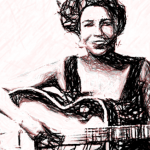
Langston Hughes is a favorite writer of mine, right along Lincoln Steffens, Peter Guralnick, Mark Twain, Bill Bryson…but I digress.
In 1942, the Chicago Defender published a review of a Memphis Minnie performance written by Hughes. It’s made its way around the horn many times and is, in my mind, priceless as it gives us the opportunity to witness a performance by Memphis Minnie without every seeing one. It’s a perfectly viable alternative to a YouTube video.
Memphis Minnie sits on top of the icebox at the 230 Club in Chicago and beats out blues on an electric guitar. A little dung-colored drummer who chews gum in tempo accompanies her, as the year’s end — 1942 — flickers to nothing, and goes out like a melted candle.
Midnight. The electric guitar is very loud, science having magnified all its softness away. Memphis Minnie sings through a microphone and her voice — hard and strong anyhow for a little woman’s — is made harder and stronger by scientific sound. The singing, the electric guitar, and the drums are so hard and so loud, amplified as they are by General Electric on top of the icebox, that sometimes the voice, the words, and melody get lost under sheer noise, leaving only the rhythm to come through clear. The rhythm fills the 230 Club with a deep and dusky heartbeat that overides all modern amplification. The rhythm is as old as Minnie’s most remote ancestor.
Memphis Minnie’s feet in her high-heeled shoes keep time to the music of her electric guitar. Her thin legs move like musical pistons. She is a slender, light-brown woman who looks like an old-maid school teacher, with a sly sense of humor. She wears glasses that fail to hide her bright bird-like eyes. She dresses neatly and sits straight in her chair perched on top of the refrigerator where the beer is kept. Before she plays she cocks her head on one side like a bird, glances from her place on the box to the crowded bar below, frowns quizzically, and looks more than ever like a colored lady teacher in a neat Southern school about to say, “Children, the lesson is on page 14 today, paragraph 2.” ….
But Memphis Minnie says nothing of the sort. Instead she grabs the microphone and yells, “Hey, now!” Then she hits a few deep chords at random, leans forward ever so slightly over her guitar, bows her head and begins to beat out a good old steady down-home rhythm on the strings — a rhythm so contagious that often it, makes the crowd holler out loud.
Then Minnie smiles. Her gold teeth flash for a split second. Her ear-rings tremble. Her left hand with dark red nails moves up and down the strings of the guitar’s neck. Her right hand with the dice ring on it picks out the tune, throbs out the rhythm, beats out the blues.
Then, through the smoke and racket of the noisy Chicago bar float Louisiana bayous, muddy old swamps, Mississippi dust and sun, cotton fields, lonesome roads, train whistles in the night, mosquitoes at dawn, and the Rural Free Delivery, that never brings the right letter. All these things cry through the strings on Memphis Minnie’s electric guitar, amplified to machine proportions — a musical version of electric welders plus a rolling mill.
Big rough old Delta Cities float in the smoke, too. Also border cities, Northern cities, Relief, W.P.A., Muscle Shoals, the jooks, “Has Anybody Seen My Pigmeat On The Line,” “See-See Rider,” St. Louis, Antoine Street, Willow Run, folks on the move who leave and don’t care. The hand with the dice-ring picks out music like this. Music with so much in it folks remember that sometimes it makes them holler out loud….
It was last year, 1941, that the war broke out, wasn’t it? Before that there wasn’t no defense work much. And the President hadn’t told the factory bosses that they had to hire colored. Before that it was W.P.A. and the Relief. It was 1939 and 1935 and 1932 and 1928 and the years that you don’t remember when your clothes got shabby and the insurance relapsed. Now, it’s 1942 — and different. Folks have jobs. Money’s circulating again. Relatives are in the Army with big insurances if they die.
Memphis Minnie, at year’s end, picks up those nuances and tunes them into the strings of her guitar, weaves them into runs and trills and deep steady chords that come through the amplifiers like the Negro heartbeats mixed with iron and steel. The way Memphis Minnie swings it sometimes makes folks snap their fingers, women get up and move their bodies, men holler, “Yes!” When they do, Minnie smiles.
But the men who run the place — they are not Negroes — never smile. They never snap their fingers, clap their hands, or move in time to the music. They just stand at the licker counter and ring up sales on the cash register. At this year’s end the sales are better than they used to be. But Memphis Minnie’s music is harder than the coins that roll across the counter. Does that mean that she understands? Or is it just science that makes the guitar strings so hard and so loud?
— “Music at Year’s End”
Langston Hughes
From The Chicago Defender
January 9, 1943
Reprinted in
“Oxford American Magazine”
Spring, 2003